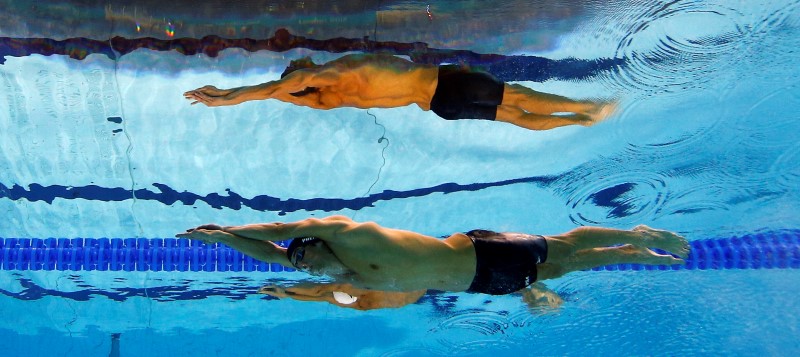Image: Michael Phelps of the U.S. is seen underwater as he swims in the men’s 200m butterfly final during the London 2012 Olympic Games at the Aquatics Centre July 31, 2012. REUTERS/Michael Dalder/File photo
![]()
By Alan Baldwin
LONDON (Reuters) – Boxers have the tale of the tape, Olympic swimmers have the tale of the taper.
Their path to peak performance is a tale of fortitude, stamina, sheer hard work — and also body shaving to transform the hairy men in briefs into smooth-skinned warriors of the pool.
As Michael Phelps, the 18 times Olympic gold medallist preparing to make another splash in Rio, wrote in his 2008 book ‘No Limits’:
“When the facial hair goes away, that’s how you know I’m getting serious’.
Tapering is the process, also common to distance athletes, where weeks and months of hard training are allowed to tail off to give the body more time to rest before the burst of competition.
With swimmers often entered for multiple distances and disciplines, no one size fits all and getting it right is no easy task. It is a time of careful calculations.
“When you taper swimmers, it’s like a haircut,” says Phelps’s coach and mentor Bob Bowman. “You never know if it’s any good until it’s too late.”
At the European championships in London in May, some competitors had been through national trials and were back into hard training while others were tapered for Olympic qualifiers.
Missy Franklin of the U.S. dives into the pool at the start of the women’s 100m freestyle swimming final at the Aquatics Centre during the London 2012 Olympic Games August 2, 2012. REUTERS/Adam Pretty/Pool/File photoThat meant Britain’s 200 metres freestyle world champion James Guy, a medal hope for Rio, raced in the 400m heats with a beard and beach-style briefs when those around him wore thigh-length suits.
“I used it as a bit of fuel,” he said. “I didn’t want to jeopardise three weeks of fitness for this meet. I wanted to train through and race hard.”
Unlike Phelps and the U.S. squad, whose qualifiers ended only in July, Britain’s Olympic trials were in April and their swimmers then went straight into hard training.
Chris Walker-Hebborn, who will compete in the 100m backstroke in Rio, set out his schedule.
“Three weeks from the day I’m supposed to race I slowly start tapering down my meterage,” the Briton told Reuters at an event organised by Adidas.
“Let’s say I (normally) do 50k a week. Then the first week in would be 40k, the second week would be 30k and the last week would be just under 20k.
“The intensity drops down, the volume drops down and it just gives your body that chance to go through the adaptation of hard training and to rejuvenate and you are just a lot fresher come race day.”
Team mates aiming at longer distances might have a shorter taper because of the fitness required, but there can also be mini-tapers and double-tapers.
Finally, there is the shaving — a clip down with two days to go and the full works a day before.
“As soon as you hit the water and you’ve had that first shave down, it’s a completely different feeling. You feel just completely different in the water,” said Walker-Hebborn.
“And then you pair that with the fact that you’re fully rested, you’re ready to go, you shave, all those feelings sort of come together. Suit on, you just sit completely differently in the water.
“It sort of helps remind your brain that this is the time to go, this is where it starts.”
(Editing by Greg Stutchbury)
Copyright 2016 Thomson Reuters. Click for Restrictions.


